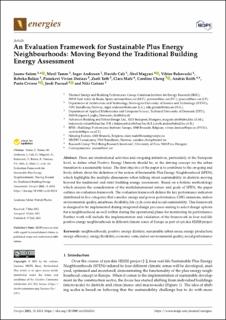An Evaluation Framework for Sustainable Plus Energy Neighbourhoods: Moving Beyond the Traditional Building Energy Assessment
| dc.contributor.author | Salom, Jaume | |
| dc.contributor.author | Tamm, Meril | |
| dc.contributor.author | Andresen, Inger | |
| dc.contributor.author | Cali, Davide | |
| dc.contributor.author | Magyari, Ábel | |
| dc.contributor.author | Bukovszki, Viktor | |
| dc.contributor.author | Balázs, Rebeka | |
| dc.contributor.author | Dorizas, Paraskevi Vivian | |
| dc.contributor.author | Toth, Zsolt | |
| dc.contributor.author | Mafé, Clara | |
| dc.contributor.author | Cheng, Caroline Y | |
| dc.contributor.author | Reith, András | |
| dc.contributor.author | Civiero, Paolo | |
| dc.contributor.author | Pascual, Jordi | |
| dc.contributor.author | Gaitani, Niki | |
| dc.date.accessioned | 2021-09-21T06:32:55Z | |
| dc.date.available | 2021-09-21T06:32:55Z | |
| dc.date.created | 2021-09-08T12:07:56Z | |
| dc.date.issued | 2021 | |
| dc.identifier.issn | 1996-1073 | |
| dc.identifier.uri | https://hdl.handle.net/11250/2779703 | |
| dc.description.abstract | There are international activities and on-going initiatives, particularly at the European level, to define what Positive Energy Districts should be, as the driving concept for the urban transition to a sustainable future. The first objective of the paper is to contribute to the on-going and lively debate about the definition of the notion of Sustainable Plus Energy Neighbourhood (SPEN), which highlights the multiple dimensions when talking about sustainability in districts moving beyond the traditional and strict building energy assessment. Based on a holistic methodology which ensures the consideration of the multidimensional nature and goals of SPEN, the paper outlines an evaluation framework. The evaluation framework defines the key performance indicators distributed in five categories that consider energy and power performance, GHG emissions, indoor environmental quality, smartness, flexibility, life cycle costs and social sustainability. This framework is designed to be implemented during integrated design processes aiming to select design options for a neighbourhood as well within during the operational phase for monitoring its performance. Further work will include the implementation and validation of the framework in four real-life positive energy neighbourhoods in different climate zones of Europe as part of syn.ikia H2020 project. | en_US |
| dc.language.iso | eng | en_US |
| dc.publisher | MDPI | en_US |
| dc.rights | Navngivelse 4.0 Internasjonal | * |
| dc.rights.uri | http://creativecommons.org/licenses/by/4.0/deed.no | * |
| dc.title | An Evaluation Framework for Sustainable Plus Energy Neighbourhoods: Moving Beyond the Traditional Building Energy Assessment | en_US |
| dc.type | Peer reviewed | en_US |
| dc.type | Journal article | en_US |
| dc.description.version | publishedVersion | en_US |
| dc.source.volume | 14 | en_US |
| dc.source.journal | Energies | en_US |
| dc.identifier.doi | 10.3390/en14144314 | |
| dc.identifier.cristin | 1932406 | |
| dc.relation.project | EC/H2020/869918 | en_US |
| cristin.ispublished | true | |
| cristin.fulltext | original | |
| cristin.qualitycode | 1 |

